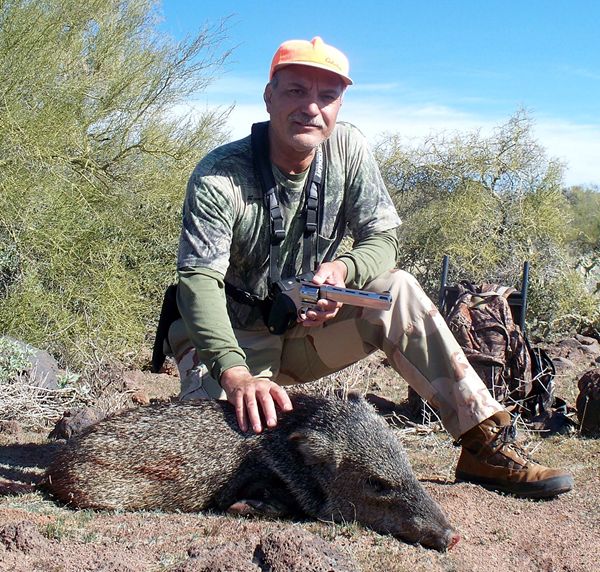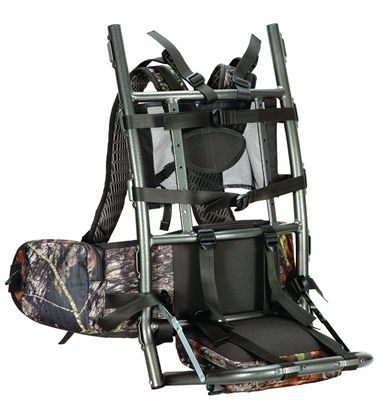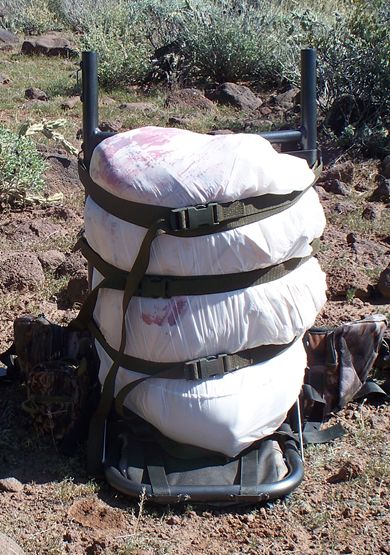
| Articles | Documents | Equipment | Events | Links | Membership | Miscellaneous | Scrapbook | Targets | What's New |
| Pig Over the Edge | February 2014 | |||||
| Dan Martinez
| ||||||
|
Life doesn’t always work out the way you might have planned. In my story for
last year’s handgun javelina hunt, I told the
tale of how my son Sam and I canoed across Bartlett Lake to hunt Unit 22. I
tagged a pig, but Sam did not. Despite having taken two deer and two elk in
his young hunting career, Sam has still not taken a javelina.
I ended the story saying, “We’ll be back next year.” Less than a month after
that hunt, Sam received the incredible news that he had been admitted to West
Point. That would mean that definitely, Sam would not be back to reprise the
javelina by canoe hunt.
With both sons now out of state, that left this old man without his favorite
hunting partners. At the time of the draw application for the spring 2014
javelina hunts, Gerhard put out the word that his app was not yet filled with
four partners. I hemmed and hawed a little. After last year’s handgun hunt
at Sam’s request, I wanted to go back to a rifle hunt, but Gerhard was adamant
that his app was for the H.A.M. (Handgun, Archery, Muzzleloader) hunt. So
there it was, HAM or hunt alone. I decided to put in on the app and just go
with the flow. The partners would be Gerhard, Wade, Michael, and Dan. We
ended up drawing unit 20B, real close to home, very familiar stomping grounds.
As opening day of the hunt drew near, emails went back and forth discussing
plans. Where would we hunt? What days were each of us planning to hunt?
Would we camp, or day-hunt from home?
Initial plans were to set up camp at the deep-in club shooting spot off the
Table Mesa Road exit. But near the last minute, we decided to try a new place
in the Black Canyon City backcountry. Wade and I would head up on Thursday
night to set up camp. Gerhard and Mike would show up just before dawn on
opening day.
Gerhard’s hunt style is light and fast. He doesn’t really camp. He pretty
much just sleeps in his Toyota. He doesn’t carry a backpack. To be out all
day, he carries only a fanny pack and what looks like a shotgun hunter’s belt
with two large pouches.
Wade had trouble trying to keep up with Gerhard on other hunts, so he decided
that he’d tag along with me on opening day. I carry a big pack, move through
the country much more “deliberately” (a euphemism for slowly), and I stop to
sit and glass more often and for longer periods. I try to cover more country
with my eyes than with my feet.
There is a fairly good road out of BCC that takes you into some steep hilly
country. Off the main road, there are some gnarly 4x4 roads that I would
rather walk than try to drive. My plan for opening morning was to walk a
deep canyon bottom that starts at the main road and follow it to where it
intersects another canyon bottom. Following that second canyon back up takes
you back to the main road, going around a mountain in the process.
So that’s what we did, except that I’m not sure what Wade thought when
halfway down that first canyon, I looked up at a high hill and said
something about heading up there. I said, “It’s not that far.” Well, he
agreed to go up there. It wasn’t far, but the higher we got, the steeper
it got. Topping out was tough, but we got it done. But I still wonder if
Wade was really thinking, “What have I gotten myself into?”
The view from up there was great. We could cover so much more country by
glassing than we ever could by walking the bottom. If there are pigs to
be found, careful work with the binoculars will reveal them. Then it
would just be a matter of getting to them.
As the morning got later, we decided to head back down and finish the
canyon-bottom walk as originally planned. Our intention was to get back
to camp for lunch. The remainder of the canyon bottom walk included
crawling into a horizontal mining hole (perhaps a pig den) with gun drawn,
but no javelina were sighted. I’m glad that I didn’t have to shoot,
because that would have been LOUD in that small space!
After lunch, we took a ridgeline walk directly out of camp. The country
we were looking over on this walk was a little more heavily brushed than
the country we glassed in the morning. It seemed like excellent javelina
habitat. Eventually the evening rolled up on us with no pig sightings
that afternoon either.
That evening in camp we learned that Michael had spotted a small herd of
piggies during his day of walking the country. He said that they were
one ridge over from him when he spotted them, about 100 yards away. He
headed over there to try to catch up with them, but when he got to that
ridge, they had disappeared into thin air. This was greatly encouraging
news. At least now we knew that this country held pigs … somewhere.
But so it went for the remainder of the three day weekend. The rest of
the boyz were heading back to work on Monday. I had decided to take
Monday and Tuesday off as vacation days. The HAM hunt runs over two
weekends. Since I’m used to hunting the General season, which runs from
a Friday to a Thursday, I guess it is my habit to take a few days off
on the other side of opening weekend.
So on Sunday afternoon, with no further pig sightings in the Black Canyon
City outback, we broke camp and headed back to civilization.
When we were originally planning to camp west of the Table Mesa exit,
one of my primary missions was going to be to get up on top of Wild Burro
Mesa.
I haven’t mentioned my other hobby in these pages for a while –
geocaching. If you need a reminder, that is a game where people go hide
a container of some sort out in the wild, post the GPS coordinates for
it up on a website, and invite other people to go find it. There is a
log to sign inside the container, then when you get back to your computer,
you also post an electronic log on the website saying that you’ve found
it. There are three geocaches on top of Wild Burro Mesa. I had never
been up there before, but in their logs online, other geocachers had
mentioned encounters with javelina on their hikes on top of the mesa.
So a visit to the top of this high plateau was the plan for my solo hunt
on Monday.
So after a shower and a comfortable night spent sleeping in my own bed
on Sunday, I left home before sun up on Monday morning, heading off to
Wild Burro Mesa.
The top of Wild Burro Mesa, a sea of
prickly pear, staghorn cholla, and basalt rocks
I parked the jeep just before the first large roller rocks, put on my
pack, grabbed my convertible shooting/walking stick, and started hoofing
it up that road.
Even on foot, the loose rocks on the road bed make ascending a dicey
proposition. I took it slow, carefully testing foot placement for
almost every step before committing with my full weight.
Eventually I got to the top. What I saw when I topped out was a vast
sea of grass, prickly pear, staghorn cholla, and basalt rocks. The mesa
top is pretty flat, and is a rather large expanse. A walk from where
the road tops out, to the southernmost portion of the table is a distance
of about 2.3 miles. The southern “tail” of the mesa extends even further,
but this is a sharp ridge, not really a plateau beyond this point.
My plan was to walk from one geocache to the next, to the next – and
hope to stumble on a herd of javelina along the way. The first geocache
was only 400-something feet from where the road tops out. Walking is
not easy up there. The rocks and cactus pretty much will not allow you
to keep a straight line. I got to the GPS zero and soon discovered the
first hidden geocache. It was a plastic military surplus decontamination
kit container. Inside was the logbook that I needed to sign.
As I was doing the necessary tasks with the geocache, I spotted a herd
of critters approaching me. They were the animals that the mesa is
named after – wild burros. I did notice their scat all over the ground
on the path that I walked. They spotted me and as I glassed them, I saw
at least a half dozen looking directly at me.
I continued what I was doing, and when I was done, I rehid the geocache
as I had found it. Now on to the next. The GPS told me that geocache
#2 was about ¾ miles away. But the topo map display on my GPS told me
that I could not take the direct route. Due to some canyons between me
and the next set of coordinates, I would need to make a right-hook path
around the canyon heads to keep my hike on top of the flat portion of
the mesa.
No problem. Since my main goal was to wander into a herd of javelina,
taking a circuitous route might increase my chances. Alas, when I
reached the site of the second geocache, no game had been sighted.
At this time it was about mid-morning. I had not eaten since getting
out of bed, so I sat and enjoyed my field breakfast. That consisted
of a bagel, some beef jerky, and a small bottle of apple juice. I
really needed the fuel at this point, because the next goal was 1¼
miles away in a straight line. But again, I would have to go around
some canyon heads to avoid dropping into, and climbing out of some
canyons. That would make my actual path over the ground from geocache
#2, about a mile-and-a-half to the third and last geocache.
Looking over the west edge of Wild Burro
Mesa
The next leg of my hike would take me close to the western edge of
the mesa, overlooking the Agua Fria arm of Lake Pleasant. This edge
is very steep. It is almost, but not quite a cliff.
About halfway to geocache #3, it happened. I spotted a herd of
javelina in front of me. They appeared to be walking from left to
right, so I altered my course to the right so that hopefully they
would walk into me. I leaned over into a duck walk as I opened up
my shooting sticks. One pig about 40 yards away made me, but must
not have been sure what I was. The pig did not panic.
I rested the long barrel of the Taurus on the padded V of the open
shooting sticks. I thumbed back the hammer and waited for the pig to
give me a broadside presentation. Because I was no longer moving, she
lost interest in me and turned away (I would later learn that she was
a sow). The hammer fell and the silence of the mesa was broken.
This second shot put the herd into motion, including my pig. The
pigs were running back and forth in all directions. Woof! Woof! …
came from multiple directions around me. Where did my pig go?
As the activity tapered off a little, I walked up to the spot where
my pig stood. After a little looking around, I spotted a pool of
bright red blood. I followed the blood trail south a short distance,
then spotted a pig standing off about 30 yards in that direction. I
held my fire, but started walking that way. As I approached, the pig
ran off, woofing. Hmm, that pig looked too healthy to be the one I
was looking for.
I started heading back to the initial blood pool, casting my eyes
back and forth widely to try to spot a downed pig somewhere. With
all the low bushes and the numerous dark brown-black basalt boulders
around here, a dead pig might be hard to spot, I thought to myself.
When I got back to the first blood pool, I tried to be doubly
observant this time. I spotted more drops that I had not seen before
– then more. The trail was leading straight toward the edge of the
mesa! Right at the edge, I now spotted a substantial pool where the
pig must have bedded while I was searching elsewhere.
As I stood there, absorbing this find, the bushes nearby shook, and
I heard another woof. The pig jumped out and started heading down
the steep slope! I saw her disappear behind a large boulder. I
eased my way over to get on top of the rock and look over. When I
did, I saw her and she saw me! Woof! She ran further down the
cliff, but not too far and not too fast. It was clear that she was
having trouble. She stopped again and I had a clear line of sight.
I fired again and she was done. But what now?
I came upon her about 70 vertical feet below the rim of the mesa.
I grabbed a leg and began to raise her up the cliff, one boulder
at a time, about three feet per yank. I was finally able to
deposit her onto flat ground on the top. The jeep was 1.6 miles
away. It was time to get to work.
| ||||||
| If you enjoyed this story, or found it useful, please consider clicking here to join the NRA at a discount of $15 off the normal membership cost. You will be supporting both this website and adding your voice in support of the Second Amendment. Thank you very much. |
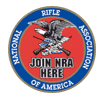
|
| Timber Ridge Bull Frame | February 2014 | ||
| Dan Martinez
| |||
|
Even though I was over 1½ miles from my vehicle, I wasn’t concerned in the least about
getting the piggy out. I’ve struggled hauling piggies out of the backcountry enough on
past hunts to finally get some smarts about it. I carried the Timber Ridge Bull Frame
on my back for the entire hunt, and now it was finally time to put it to the use intended.
In recent years, National Forests across Arizona have been increasing restrictions on
motorized game retrieval. It used to be that if you could get your vehicle up to your
downed critter, you were perfectly within the law to do so. Not so much anymore. More
and more, Arizona hunters are having to learn to quarter and haul their meat out of the
field on their backs.
A recent experience with quartering and packing came in the fall of 2010 on Sam’s youth
elk hunt. In that case, we had to quarter and backpack Sam’s elk out because of downed
logs that prevented us from getting wheels to the critter. At the time, I only had a
plastic pack frame from a regular backpacking pack. It really was not a meat packing
“freighter” frame. It worked fine, but we had to improvise how to lash the meat to the
frame.
So within a year of that experience, I purchased the Timber Ridge Bull Frame. Who the
heck is Timber Ridge? They appear to be a small hunting products company based in
Indiana. As I write this, you can buy the Bull Frame on
Amazon.com for $67.40, but the price is constantly changing.
What I like about it is its relatively small size for a freighter frame. It has a fold
down shelf for supporting an unwieldy load. The two uprights at the top allow you to
hang a standard soft day pack on it. For the javelina hunt, I had my Cabela’s Whitetail
day pack strapped on.
The frame alone weighs 4.4 pounds. Add to that a loaded daypack, and yeah, you are
hauling around a somewhat heavy beast on your back, before you have even shot a beast.
Mitigating that is a wide, generously padded waist belt, and well-padded shoulder straps.
Roomy side pouches are built in to the waist belt, plus there’s a large two-compartment
pouch on the bottom attached to the load shelf. I use this bottom pouch to store game
care essentials for the field. I carry a sturdy cotton game bag, shoulder-length
plastic field dressing gloves and four buckle straps for lashing on the game.
Lashing straps are not included with the frame, so you must provide your own. Packing
along a length of parachute cord would be another option. There are a total of five
lashing points on each upright.
Sam was the first one to haul game with this frame on last year’s pig hunt. One
lesson we learned from that is that after putting the game in the game bag, blood
will eventually drip through the cotton and onto you. So for this year’s pig hunt
I added a white plastic trash bag to the kit to put over the cotton game bag before
lashing it onto the frame.
But for the handgun javelina hunt, that was not a problem. I alternately wore my
gun holster on the frame’s waist belt strap, where it rode somewhat in front of my
hip, and on my pants belt on the side of my hip. When I wore the holster on my
pants belt, I wore the frame’s waist belt a little higher on my body, passing it
behind the gun’s grip, but over the holster’s belt loop.
I gutted, skinned, and beheaded the piggy right there where I dropped her off on the
top. I wanted to minimize the weight I would need to carry. The whole operation went
very smoothly. I used two of the lashing straps to hang the piggy from the branches
of a nearby Palo Verde tree to skin her out -- very handy.
After lashing the piggy to the frame, I was still able to hang my daypack over and
behind the piggy package on the frame. Thus, I’m sure that my total load was around
50 pounds, but it was very manageable on the long hike out.
| |||
| If you enjoyed this story, or found it useful, please consider clicking here to join the NRA at a discount of $15 off the normal membership cost. You will be supporting both this website and adding your voice in support of the Second Amendment. Thank you very much. |

|
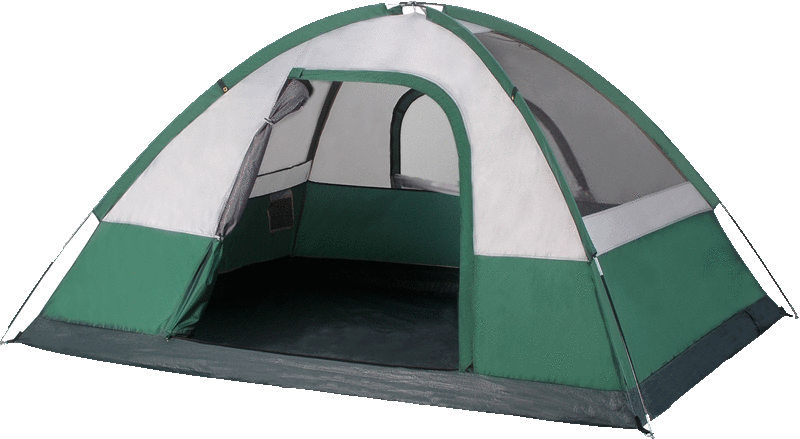
|
|
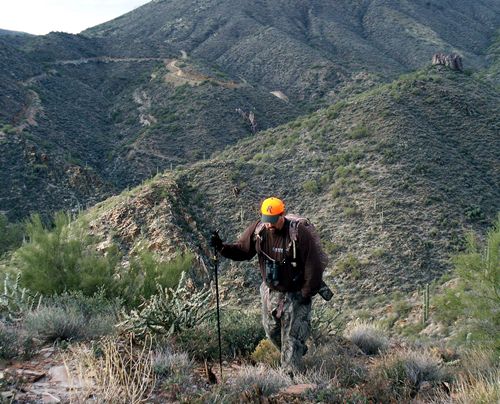
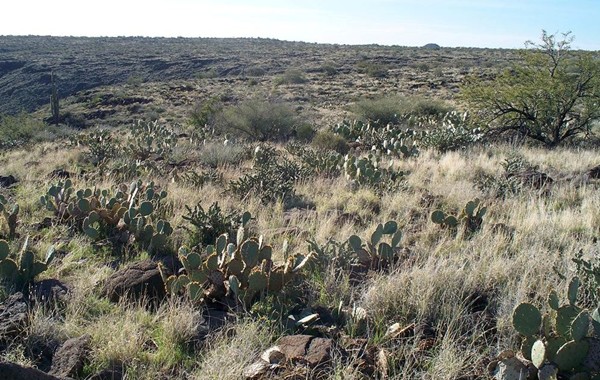
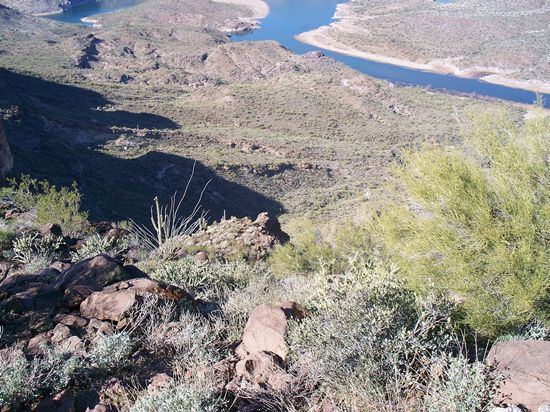
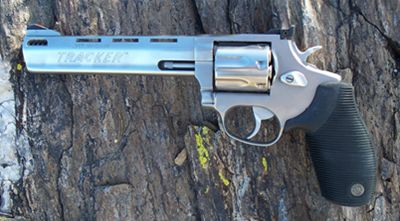
 I decided that my primary tool on this year’s hunt would be a revolver.
Last year I took only my second handgun javelina with a scoped, rifle
caliber, single shot specialty pistol – a Magnum Research Lone Eagle in
.260 Remington. This year I wanted to get back to basics, so my Taurus
Tracker in .357 Magnum received the call of duty.
I decided that my primary tool on this year’s hunt would be a revolver.
Last year I took only my second handgun javelina with a scoped, rifle
caliber, single shot specialty pistol – a Magnum Research Lone Eagle in
.260 Remington. This year I wanted to get back to basics, so my Taurus
Tracker in .357 Magnum received the call of duty.
